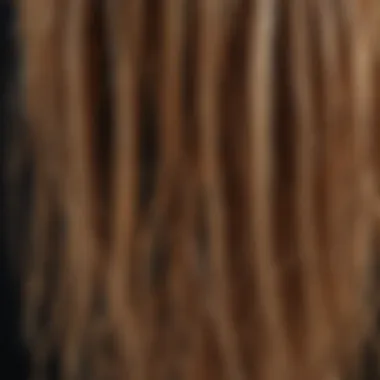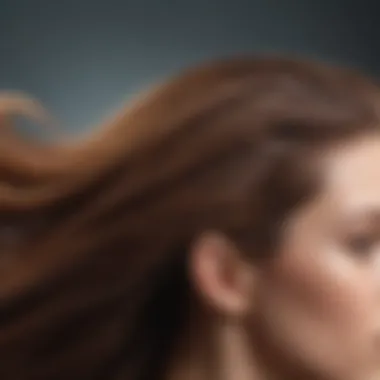Does Keratin Promote Hair Growth? Understanding the Science


Intro
Hair growth is a topic of great interest for many. As various treatments and products flood the market, one ingredient frequently mentioned is keratin. Keratin is a structural protein crucial for the integrity of hair. Understanding its role raises important questions about its effectiveness in promoting hair growth. This article investigates the relationship between keratin and hair health, establishing whether keratin treatments are genuinely beneficial or merely cosmetic.
Overview of Research Topic
Brief Background and Context
Keratin exists naturally in human hair, skin, and nails. It serves to protect and strengthen these structures. Due to its importance, it is common for beauty products to claim benefits associated with keratin. Treatments containing keratin often aim to repair and smooth hair. However, the scientific community is divided on whether keratin treatment promotes genuine hair growth or simply enhances the appearance and condition of hair.
Importance in Current Scientific Landscape
Current research is pivotal in the realm of hair health. Given that hair loss affects many individuals, understanding all contributing factors, including keratin’s role, is essential. Furthermore, the relationship between nutrition, genetics, and hormonal balance must not be overlooked. These elements greatly influence hair growth, and keratin may play a part in a broader equation. This article will sift through these complex relationships and clarify the actual role keratin plays in hair growth.
Methodology
Research Design and Approach
To provide a comprehensive overview, this article employs a multidisciplinary approach. The analysis includes a review of existing literature, clinical studies, and expert opinions. The design intends to piece together available research on keratin and its implications for hair health.
Data Collection Techniques
Data collection entails searching for peer-reviewed articles, reputable health websites, and testimonies from individuals who used keratin treatments. Collecting diverse perspectives helps illuminate the multifaceted nature of hair growth and the varying effects of keratin.
"While keratin is vital as a building block of hair, its direct influence on hair growth remains inconclusive."
By understanding the broader context surrounding hair care treatments, a clearer understanding can be formulated regarding keratin’s role and efficacy.
Prolusion to Keratin
Keratin plays a significant role in hair health, acting as a fundamental building block. Understanding keratin is essential in exploring its impact on hair growth. This section will clarify what keratin is and highlight its different forms.
Definition of Keratin
Keratin is a fibrous structural protein found in several parts of the human body, including hair, skin, and nails. It serves a protective function and contributes to the strength and resilience of hair. This protein is distinct from other proteins due to its unique structure, which includes long chains of amino acids that twist together to form a stable filament. This structural characteristic is why keratin is special, especially in the context of hair care.
Types of Keratin in the Body
Keratin can be classified mainly into two categories: alpha-keratin and beta-keratin. Each of these types has specific properties and functions that contribute to hair health and structure.
Alpha-Keratin
Alpha-keratin is the predominant form of keratin in mammals, including humans. It is flexible and supportive, making it ideal for forming hair and skin. One of the essential aspects of alpha-keratin is its ability to easily undergo changes, which benefits hair styling and treatments.
The unique feature of alpha-keratin is its coiled structure, which allows it to stretch and bend without breaking. This characteristic is advantageous for individuals seeking hair products that offer flexibility and a degree of protection, as alpha-keratin maintains hair's integrity during styling. However, while it provides numerous benefits, it does not play a direct role in promoting hair growth.
Beta-Keratin
Beta-keratin, on the other hand, has a more rigid structure compared to its alpha counterpart. It is found in the feathers of birds and the scales of reptiles. In human hair, beta-keratin adds to the overall strength but is less prevalent. Its key characteristic is its tougher composition, which makes it ideal for protective functions rather than flexibility.
The presence of beta-keratin in hair provides added strength, reducing breakage and promoting overall durability. While it is not the primary form of keratin in human hair, its role cannot be discounted, especially when discussing protective hair treatments. Yet, like alpha-keratin, it does not directly enhance hair growth but contributes to healthier hair that may sustain growth better.
The Structure of Hair


Understanding the structure of hair is essential to comprehend how keratin functions within it. Hair is not merely a strand that grows from the scalp; it is a complex structure consisting of various components that contribute to its health and appearance. This section will delve deeper into the anatomy of hair and the specific roles keratin plays in maintaining its integrity and strength.
Anatomy of Hair
The human hair structure can be broken down into three main layers: the cuticle, cortex, and medulla. Each layer plays a distinct role in protecting and determining the characteristics of hair.
- Cuticle: The outermost layer, the cuticle consists of flat, overlapping cells. This layer serves as a protective shield against environmental damage, such as UV rays or pollutants. It also helps in controlling moisture loss and retaining the internal structure of the hair.
- Cortex: It is the thickest layer of the hair and is where the true texture and strength are found. The cortex contains long keratin fibers that provide elasticity and strength. It also contains pigments that determine the color of the hair. Damage to this layer can lead to frizz and breakage, indicating the importance of its health.
- Medulla: The innermost layer, which is often absent in finer hair types, serves no purpose in terms of strength or color but may have a role in the overall structure of the hair.
Understanding these layers is important, as any weakness or damage to them can result in hair loss or poor hair health. The condition of hair is directly related to its internal structure and the proteins that compose it, particularly keratin.
Keratin's Role in Hair Structure
Keratin is a fibrous protein present in hair that provides both structure and resilience. It is a crucial element that contributes to the health and strength of hair strands.
- Strength and Flexibility: The attributes of keratin allow hair to withstand various physical stresses. The protein forms a robust framework that supports the hair and prevents breakage while allowing flexibility.
- Moisture Retention: Keratin helps in retaining moisture, which is essential for preventing dryness. When hair loses moisture, it becomes brittle and more prone to damage.
- Protection Against Environmental Factors: Keratin acts as a barrier against external aggressors like pollution, heat, and chemicals that can weaken the hair structure.
Overall, keratin's contribution to hair structure underscores its importance in maintaining healthy hair. The health of the hair directly impacts its growth, making an understanding of this relationship vital in discussions of hair care and growth.
"The integrity of keratin in hair not only determines its strength but also plays a significant role in hair growth and overall hair health."
Future sections will elaborate on how keratin treatments affect these structures, examining the dynamics between keratin, hair care practices, and hair growth.
Understanding Hair Growth
Understanding hair growth is critical because it establishes a framework for assessing the effects of keratin on hair. Each phase of hair growth has its own characteristics and influences the overall health of hair. Knowing these phases helps in dispelling myths about keratin treatments and their effectiveness in promoting hair growth.
Phases of the Hair Growth Cycle
The hair growth cycle consists of three distinct phases: anagen, catagen, and telogen. Understanding these phases paves the way for a better comprehension of how keratin and other factors contribute to hair health and density.
Anagen Phase
The anagen phase is the active growth stage of hair. Lasting several years, it significantly contributes to hair length. The key characteristic of this phase is that hair grows continuously and robustly. This phase is beneficial for anyone seeking to have long and thick hair, as the longer this phase lasts, the more hair one can potentially grow.
Unique Features of the Anagen Phase
One unique feature of the anagen phase is the rapid cell division occurring in the hair follicles. This division is crucial, as it is the basis on which hair strands are formed. The main advantage here is that a healthy and prolonged anagen phase contributes to overall hair growth. Conversely, any disruptions or shortenings of this phase can lead to hair thinning or loss.
Catagen Phase
The catagen phase is a transitional stage that usually lasts a few weeks. During this time, hair growth slows, and the hair follicle shrinks. The key characteristic here is that this phase marks the end of the active hair growth cycle, which may seem counterintuitive for individuals seeking thicker hair. However, understanding this is essential for color treatments and various styling practices.
Unique Features of the Catagen Phase
One unique feature of the catagen phase is the formation of a club hair, which is a hair that has stopped growing. The advantage of this phase is that it allows the follicle to prepare for the final stage of the cycle. The downside is that if hair does not transition effectively from this phase to the next, it may lead to hair loss.
Telogen Phase
The telogen phase is the resting stage of the hair growth cycle and can last several months. During this period, the hair does not grow, but it remains attached to the follicle. This phase is essential as it prepares to shed the old hair and starts a new cycle. A key characteristic is that hair remains dormant during this time, which can mislead individuals into thinking their hair is stagnant.
Unique Features of the Telogen Phase
One unique feature of the telogen phase is that it is when old hair naturally sheds to make way for new growth. This cycle is important for maintaining a healthy balance of hair and scalp health. The advantage is that, ideally, the shedding leads to fresher hair growth. However, if many hairs enter this phase too quickly, it can result in noticeable thinning or bald spots.
Factors Influencing Hair Growth
Several factors influence hair growth, including genetics, hormonal changes, and overall health and nutrition. These elements play vital roles in determining how well the hair growth cycle proceeds and ultimately informs any connection between keratin and hair growth.
Genetics


Genetics significantly influence hair growth patterns and characteristics. This includes everything from hair texture to growth cycle length. A critical factor to consider is that genetic predisposition can determine how much hair one has or how quickly it grows, making it a focal point in hair health discussions.
Unique Features of Genetics
Genetic traits are passed down through generations. This means that if family members exhibit thinning hair or slow growth, it is likely to affect you as well. While you cannot change your genetics, understanding them can lead to tailored approaches for hair care.
Hormonal Changes
Hormones are key drivers in the hair growth cycle. They can significantly alter how hair reacts to different treatments, including keratin applications. A crucial aspect is understanding how fluctuations in hormones, like during puberty or menopause, can lead to accelerated or inhibited hair growth.
Unique Features of Hormonal Changes
Hormonal changes can cause hair to enter phases more quickly or slowly. From a benefits perspective, recognizing these changes can help in managing expectations when pursuing treatments for hair growth. The downside is that significant hormonal imbalances can lead to unwanted hair loss or thinning.
Health and Nutrition
Health and nutrition are foundational aspects influencing hair growth. A balanced diet rich in vitamins and minerals promotes healthy hair. Recognizing nutrients essential for hair growth can empower individuals to make dietary choices that support their hair's overall health.
Unique Features of Health and Nutrition
Certain vitamins, like biotin and vitamin E, have been shown to enhance hair health. The advantage of focusing on nutrition is that it is a controllable aspect of hair care. However, neglecting these factors can lead to deficiencies that detrimentally affect hair growth and health.
Keratin Treatments and Their Effects
The section on keratin treatments and their effects is crucial in understanding whether keratin contributes to hair growth. Keratin treatments are widely adopted in the beauty industry for their perceived benefits in enhancing hair quality. These treatments promise improved hair texture, increased smoothness, and enhanced shine, among other claims. In this section, we will explore various types of keratin treatments, their efficacy in the short and long term, and also consider any potential drawbacks. Understanding these elements provides insight into how keratin interacts with hair and whether it can indeed influence hair growth.
Types of Keratin Treatments
Keratin treatments come in several forms, each designed with specific goals in mind. The most common types are:
- Keratin Smoothing Treatments: These treatments aim to reduce frizz and enhance the hair's shine. They often use heat to bond keratin to the hair strands.
- Brazilian Blowout: This specific treatment not only straightens hair but also adds a protective layer of keratin, which can make hair appear healthier.
- Keratin Masks: These are deep conditioning treatments infused with keratin, designed to restore moisture and strength to dry hair.
Each of these treatments utilizes keratin in different ways, offering various benefits depending on the individual’s hair type and needs.
Efficacy of Keratin Treatments
Immediate Effects
The immediate effects of keratin treatments typically involve noticeable enhancements in hair appearance. Many individuals observe that their hair feels smoother and looks shinier right after the treatment. This characteristic is vital as it provides a quick solution for those seeking instant gratification in their hair care routines. The unique feature of immediate effects lies in how they can transform hair from dull to vibrant almost instantly. However, it is essential to note that these results may not last indefinitely and can require frequent touch-ups, which could be a disadvantage.
Long-Term Benefits
When assessing long-term benefits, it becomes necessary to consider how keratin treatments can affect the overall health of the hair over time. Users often report reduced breakage and improved manageability, making styling easier and less time-consuming. This aspect becomes appealing for those with busy lifestyles. The unique feature of long-term benefits is the potential for healthier hair as the nutritional elements in the treatment may continue to nurture the hair fibers. However, users should be cautious, as results can vary depending on individual hair type and the frequency of treatments.
Potential Risks and Side Effects
While keratin treatments offer various benefits, they also come with potential risks and side effects. Common issues reported include:
- Chemical Damage: Some keratin treatments contain formaldehyde, which can lead to hair damage.
- Irritation: The process may cause scalp irritation for some individuals, especially if they have sensitive skin.
- Building Up: Overuse of certain treatments can lead to excessive buildup on the hair, making it weigh down and appear lifeless.
Given these factors, it is crucial for individuals to weigh the pros and cons before undergoing keratin treatments. A thorough understanding allows one to make informed decisions regarding their hair care regimen.
Research and Evidence
The exploration of keratin's role in hair growth cannot be conducted without rigorous examination of current research and evidence. Valid studies are necessary for understanding how keratin interacts with hair health and growth. Researchers work to uncover the biochemical properties of keratin and its effectiveness in treatments aimed at enhancing hair condition. Evaluating recent findings can provide clarity on misconceptions and highlight the actual benefits and limitations of keratin-based products.
It is essential to consider the scientific rigor behind these studies. Well-designed research not only discovers new knowledge but also aids in translating findings into practical applications for those looking to enhance their hair growth and overall hair health.
Current Studies on Keratin and Hair Growth


Recent studies have increasingly focused on the impact of keratin on hair growth. Research has shown that keratin is a vital protein that contributes to the structural integrity of hair. Various scholarly articles outline how keratin treatments can provide a short-term improvement in hair appearance and manageability, but the question remains: does it actually promote hair growth?
Some studies observe an improvement in hair texture and strength post-treatment, suggesting that keratin may enhance hair's resilience against breaking or damage. While these benefits are significant, they do not necessarily equate to increased hair growth. For instance:
- A study published in a reputable journal indicated that keratin, when used in conjunction with other amino acids, showed an increase in hair volume.
- Another research highlighted that while keratin can restore damaged hair, it does not directly influence the follicular activity required for new hair growth.
This nuanced understanding is crucial for consumers seeking effective solutions for hair health.
Limitations of Existing Research
Although progress has been made, limitations exist within the current body of research regarding keratin and its effects on hair growth. One significant challenge is the variability in study methods. Not all studies account for the myriad of other factors that affect hair growth, such as genetics, nutrition, and hormonal balance. As a result, conclusions reached may not be universally applicable.
Moreover, many studies focus primarily on the cosmetic advantages of keratin treatments instead of their physiological impact. Factors like:
- Sample size: Some studies involve a limited number of participants, which may skew results.
- Subjectivity: Many outcomes rely on self-reported data from participants, introducing potential bias.
- Duration: Short-term studies may not sufficiently address long-term effects or benefits of keratin treatments on hair growth over time.
These limitations underscore the need for continued research to establish a clearer understanding of keratin's role and effects.
Understanding the research landscape allows for more informed decisions regarding hair care products.
Common Myths About Keratin
Understanding the common myths surrounding keratin is crucial for those interested in hair health and growth. These myths often shape how people perceive hair treatments and influence their choices in products. There are a lot of misconceptions regarding the efficacy of keratin and its role in promoting hair growth. Being informed can help you make better decisions about your hair care regimen and avoid wasting time and money on ineffective treatments.
Myths Debunked
One widespread belief is that keratin treatments can make hair grow faster. In reality, keratin does not have the ability to influence hair growth directly. It is mainly a structural protein, providing strength and resilience to the hair. Thus, while keratin treatments may improve the overall appearance of hair through smoothing and shine, they do not alter the rate of hair growth.
Another myth is that all keratin treatments are similar. There are various types of treatments available, such as Brazilian Blowouts and formaldehyde-free options. Each type may contain different ingredients and achieve different results. For instance, some treatments may offer a temporary smoothing effect, while others can lead to long-lasting changes in hair texture.
Lastly, people often believe that keratin will solve all hair problems. This statement oversimplifies a complex issue. While keratin can repair damaged strands and enhance luster, it cannot address fundamental issues like hormonal imbalances or nutritional deficiencies that might be affecting hair health.
Understanding the Misconceptions
Misconceptions about keratin often stem from marketing strategies that exaggerate its benefits. Many products advertise themselves as 'miracle cures' without providing scientific backing. It is vital to approach hair care products with skepticism and conduct thorough research.
For those looking to improve their hair, understanding the role of keratin is important. Keratin contributes to the strength and integrity of hair, but it does not stimulate growth. Knowing the real function of keratin helps in setting realistic expectations from treatments.
"Keratin positively impacts hair structure but does not directly promote hair growth."
In summary, being aware of these myths paves the way for better hair care choices. It allows individuals to select products that genuinely contribute to their hair's health, rather than falling for misleading claims.
The End: The Impact of Keratin on Hair Growth
Understanding the role of keratin in hair growth is fundamental for anyone interested in hair health. This section unpacks the various aspects of keratin, its application in treatments, and the broader implications for nutritional and hormonal considerations. It is crucial because hair growth affects not only aesthetics but also self-esteem and overall well-being.
Summary of Findings
Through analysis, we learned that keratin itself does not directly stimulate hair growth. Instead, it serves primarily as a structural protein, providing strength and resilience to hair strands. The findings align with the notion that while keratin treatments can improve the appearance of hair by reducing frizz and enhancing shine, they do not actively promote growth. The distinction between treating hair and influencing the biological growth mechanisms is significant.
Key points include:
- Keratin as a structural protein: While it is essential for hair strength, its role in growth is indirect.
- Treatment benefits: Keratin treatments can result in smoother and healthier-looking hair.
- Factors influencing growth: Genetic, hormonal, and nutritional factors contribute much more to hair growth than keratin alone.
Final Thoughts
The conversation around keratin in relation to hair growth is multilayered and often complicated by marketing narratives. As a result, it is imperative to approach products and treatments, promising hair growth, with a discerning mindset. The emphasis should be on overall hair health rather than the mere presence of keratin in hair products.
"Prioritizing a complete approach towards hair care, which includes proper nutrition and health management, is key to achieving optimal results."
The relationship between keratin and hair deserves ongoing investigation, particularly in the context of modern treatments and holistic wellness.



